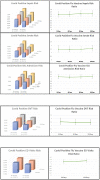Examining the potential benefits of the influenza vaccine against SARS-CoV-2: A retrospective cohort analysis of 74,754 patients
- PMID: 34343191
- PMCID: PMC8330918
- DOI: 10.1371/journal.pone.0255541
Examining the potential benefits of the influenza vaccine against SARS-CoV-2: A retrospective cohort analysis of 74,754 patients
Abstract
Introduction: Recently, several single center studies have suggested a protective effect of the influenza vaccine against severe acute respiratory syndrome coronavirus-2 (SARS-CoV-2). This study utilizes a continuously updated Electronic Medical Record (EMR) network to assess the possible benefits of influenza vaccination mitigating critical adverse outcomes in SARS-CoV-2 positive patients from 56 healthcare organizations (HCOs).
Methods: The de-identified records of 73,346,583 patients were retrospectively screened. Two cohorts of 37,377 patients, having either received or not received influenza vaccination six months-two weeks prior to SARS-CoV-2 positive diagnosis, were created using Common Procedural Terminology (CPT) and logical observation identifiers names and codes (LOINC) codes. Adverse outcomes within 30, 60, 90, and 120 days of positive SARS-CoV-2 diagnosis were compared between cohorts. Outcomes were assessed with stringent propensity score matching including age, race, ethnicity, gender, hypertension, diabetes, hyperlipidemia, chronic obstructive pulmonary disease (COPD), obesity, heart disease, and lifestyle habits such as smoking.
Results: SARS-CoV-2-positive patients who received the influenza vaccine experienced decreased sepsis (p<0.01, Risk Ratio: 1.361-1.450, 95% CI:1.123-1.699, NNT:286) and stroke (p<0.02, RR: 1.451-1.580, 95% CI:1.075-2.034, NNT:625) across all time points. ICU admissions were lower in SARS-CoV-2-positive patients receiving the influenza vaccine at 30, 90, and 120 days (p<0.03, RR: 1.174-1.200, 95% CI:1.003-1.385, NNT:435), while approaching significance at 60 days (p = 0.0509, RR: 1.156, 95% CI:0.999-1.338). Patients who received the influenza vaccine experienced fewer DVTs 60-120 days after positive SARS-CoV-2 diagnosis (p<0.02, RR:1.41-1.530, 95% CI:1.082-2.076, NNT:1000) and experienced fewer emergency department (ED) visits 90-120 days post SARS-CoV-2-positive diagnosis (p<0.01, RR:1.204-1.580, 95% CI: 1.050-1.476, NNT:176).
Conclusion: Our analysis outlines the potential protective effect of influenza vaccination in SARS-CoV-2-positive patients against adverse outcomes within 30, 60, 90, and 120 days of a positive diagnosis. Significant findings favoring influenza vaccination mitigating the risks of sepsis, stroke, deep vein thrombosis (DVT), emergency department (ED) & Intensive Care Unit (ICU) admissions suggest a potential protective effect that could benefit populations without readily available access to SARS-CoV-2 vaccination. Thus further investigation with future prospective studies is warranted.
Conflict of interest statement
Dr. Holton serves as a consultant for Acelity/3M and Stryker. Dr. Slavin, Ms. Taghioff, and Dr. Singh have no relevant disclosures. The authors have not received any consulting fees, stock options, research funding, capital equipment, or educational grants from TriNetX.
Figures



Similar articles
-
The impact of influenza vaccination on surgical outcomes in COVID-19 positive patients: An analysis of 43,580 patients.PLoS One. 2023 Mar 10;18(3):e0281990. doi: 10.1371/journal.pone.0281990. eCollection 2023. PLoS One. 2023. PMID: 36897891 Free PMC article.
-
COVID-19 is associated with higher risk of venous thrombosis, but not arterial thrombosis, compared with influenza: Insights from a large US cohort.PLoS One. 2022 Jan 12;17(1):e0261786. doi: 10.1371/journal.pone.0261786. eCollection 2022. PLoS One. 2022. PMID: 35020742 Free PMC article.
-
The influence of SARS-CoV-2 vaccination on post-operative outcomes in microsurgery patients.Microsurgery. 2022 Oct;42(7):685-695. doi: 10.1002/micr.30940. Epub 2022 Jul 15. Microsurgery. 2022. PMID: 35838137 Free PMC article.
-
A Systematic Review and Clinical Presentation of Central Nervous System Complications of Severe Acute Respiratory Syndrome Coronavirus 2 in Hospitalized Pediatric Patients During the Coronavirus Disease 2019 Pandemic in Israel.Pediatr Neurol. 2024 Apr;153:68-76. doi: 10.1016/j.pediatrneurol.2024.01.008. Epub 2024 Jan 11. Pediatr Neurol. 2024. PMID: 38335916
-
Association between influenza vaccination and SARS-CoV-2 infection and its outcomes: systematic review and meta-analysis.Chin Med J (Engl). 2022 Oct 5;135(19):2282-2293. doi: 10.1097/CM9.0000000000002427. Chin Med J (Engl). 2022. PMID: 36378238 Free PMC article.
Cited by
-
Influenza and Influenza-Like Respiratory Virus Infections in Children During the 2019/20 Influenza Seazon and the COVID-19 Pandemic in Poland: Data from the Department of Influenza Research, the National Influenza Center at the National Institute of Public Health, National Institute of Hygiene-National Research Institute and 16 Voivodeship Sanitary and Epidemiological Stations.Med Sci Monit. 2021 Dec 12;27:e934862. doi: 10.12659/MSM.934862. Med Sci Monit. 2021. PMID: 34897266 Free PMC article.
-
Identification of groups at high risk for under-coverage of seasonal influenza vaccination: A national study to inform vaccination priorities during the COVID-19 pandemic.Ann Epidemiol. 2022 Apr;68:16-23. doi: 10.1016/j.annepidem.2021.12.008. Epub 2021 Dec 17. Ann Epidemiol. 2022. PMID: 34923117 Free PMC article.
-
Characteristics of pediatric COVID-19 infections and the impact of influenza and COVID-19 vaccinations during the first two years of the pandemic.Front Pediatr. 2023 Oct 12;11:1046680. doi: 10.3389/fped.2023.1046680. eCollection 2023. Front Pediatr. 2023. PMID: 37900675 Free PMC article.
-
Influenza and Pneumococcal Vaccination and the Risk of COVID-19: A Systematic Review and Meta-Analysis.Diagnostics (Basel). 2022 Dec 7;12(12):3086. doi: 10.3390/diagnostics12123086. Diagnostics (Basel). 2022. PMID: 36553093 Free PMC article. Review.
-
A cross-sectional study from Qatar on the effect of influenza vaccination on the severity of COVID-19.Medicine (Baltimore). 2023 Sep 15;102(37):e35107. doi: 10.1097/MD.0000000000035107. Medicine (Baltimore). 2023. PMID: 37713897 Free PMC article.
References
-
- COVID-19 map—johns Hopkins Coronavirus resource Center. Jhu.edu. Accessed January 29, 2021. https://coronavirus.jhu.edu/map.html.
-
- TriNetX. Trinetx.com. Published May 18, 2018. Accessed January 29, 2021. https://www.trinetx.com.
-
- Singh S, Bilal M, Pakhchanian H, Raiker R, Kochhar GS, Thompson CC. Impact of obesity on outcomes of patients with coronavirus disease 2019 in the united states: A multicenter electronic health records network study. Gastroenterology. 2020;159(6):2221-2225.e6. doi: S0016-5085(20)35067-8 [pii]. doi: 10.1053/j.gastro.2020.08.028 - DOI - PMC - PubMed
MeSH terms
Substances
LinkOut - more resources
Full Text Sources
Medical
Miscellaneous

